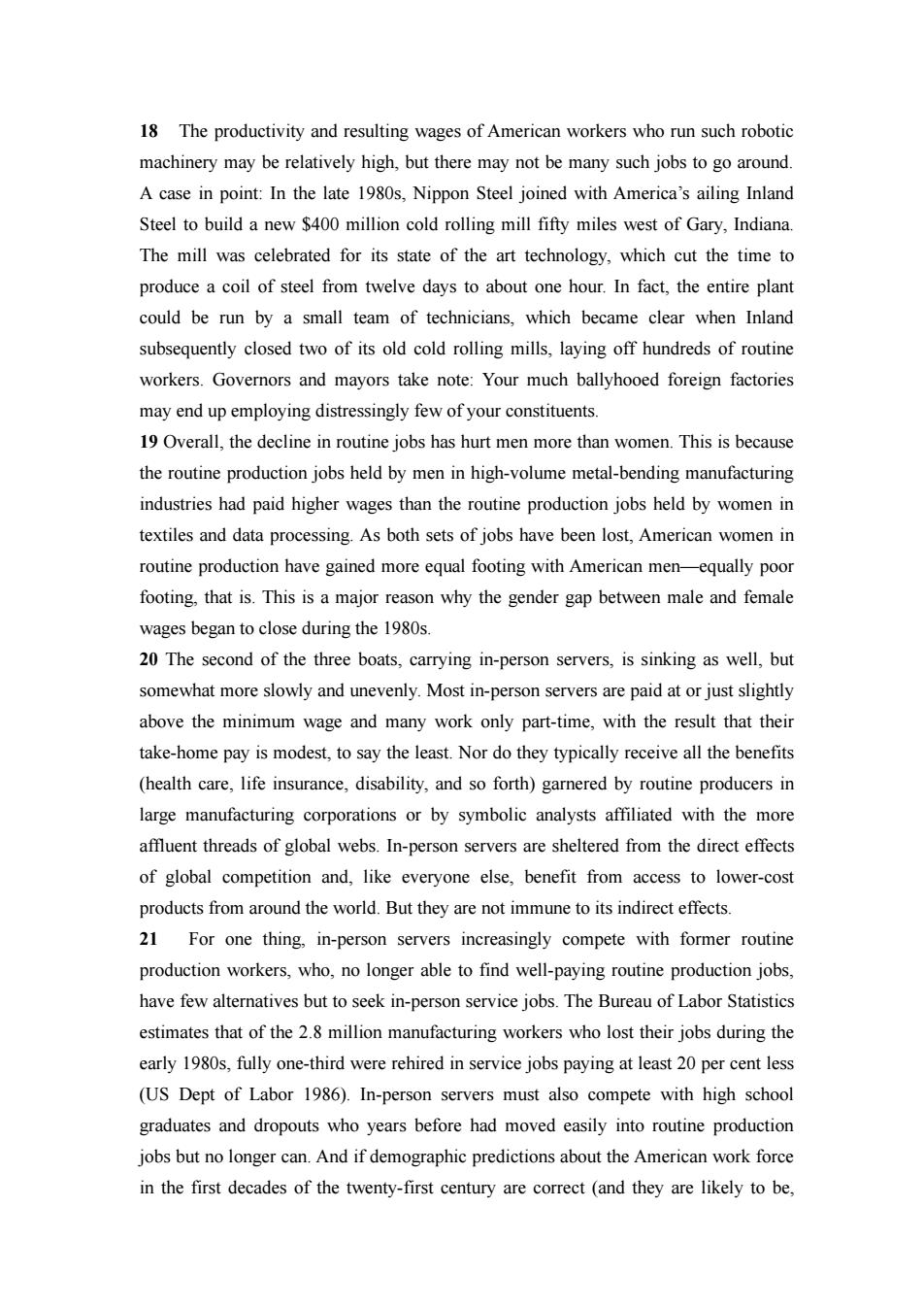正在加载图片...

18 The productivity and resulting wages of American workers who run such robotic machinery may be relatively high,but there may not be many such jobs to go around. A case in point:In the late 1980s,Nippon Steel joined with America's ailing Inland Steel to build a new $400 million cold rolling mill fifty miles west of Gary,Indiana The mill was celebrated for its state of the art technology,which cut the time to produce a coil of steel from twelve days to about one hour.In fact,the entire plant could be run by a small team of technicians,which became clear when Inland subsequently closed two of its old cold rolling mills,laying off hundreds of routine workers.Governors and mayors take note:Your much ballyhooed foreign factories may end up employing distressingly few of your constituents. 19 Overall,the decline in routine jobs has hurt men more than women.This is because the routine production jobs held by men in high-volume metal-bending manufacturing industries had paid higher wages than the routine production jobs held by women in textiles and data processing.As both sets of jobs have been lost,American women in routine production have gained more equal footing with American men-equally poor footing,that is.This is a major reason why the gender gap between male and female wages began to close during the 1980s. 20 The second of the three boats,carrying in-person servers,is sinking as well,but somewhat more slowly and unevenly.Most in-person servers are paid at or just slightly above the minimum wage and many work only part-time,with the result that their take-home pay is modest,to say the least.Nor do they typically receive all the benefits (health care,life insurance,disability,and so forth)garnered by routine producers in large manufacturing corporations or by symbolic analysts affiliated with the more affluent threads of global webs.In-person servers are sheltered from the direct effects of global competition and,like everyone else,benefit from access to lower-cost products from around the world.But they are not immune to its indirect effects. 21 For one thing,in-person servers increasingly compete with former routine production workers,who,no longer able to find well-paying routine production jobs, have few alternatives but to seek in-person service jobs.The Bureau of Labor Statistics estimates that of the 2.8 million manufacturing workers who lost their jobs during the early 1980s,fully one-third were rehired in service jobs paying at least 20 per cent less (US Dept of Labor 1986).In-person servers must also compete with high school graduates and dropouts who years before had moved easily into routine production jobs but no longer can.And if demographic predictions about the American work force in the first decades of the twenty-first century are correct (and they are likely to be,18 The productivity and resulting wages of American workers who run such robotic machinery may be relatively high, but there may not be many such jobs to go around. A case in point: In the late 1980s, Nippon Steel joined with America’s ailing Inland Steel to build a new $400 million cold rolling mill fifty miles west of Gary, Indiana. The mill was celebrated for its state of the art technology, which cut the time to produce a coil of steel from twelve days to about one hour. In fact, the entire plant could be run by a small team of technicians, which became clear when Inland subsequently closed two of its old cold rolling mills, laying off hundreds of routine workers. Governors and mayors take note: Your much ballyhooed foreign factories may end up employing distressingly few of your constituents. 19 Overall, the decline in routine jobs has hurt men more than women. This is because the routine production jobs held by men in high-volume metal-bending manufacturing industries had paid higher wages than the routine production jobs held by women in textiles and data processing. As both sets of jobs have been lost, American women in routine production have gained more equal footing with American men—equally poor footing, that is. This is a major reason why the gender gap between male and female wages began to close during the 1980s. 20 The second of the three boats, carrying in-person servers, is sinking as well, but somewhat more slowly and unevenly. Most in-person servers are paid at or just slightly above the minimum wage and many work only part-time, with the result that their take-home pay is modest, to say the least. Nor do they typically receive all the benefits (health care, life insurance, disability, and so forth) garnered by routine producers in large manufacturing corporations or by symbolic analysts affiliated with the more affluent threads of global webs. In-person servers are sheltered from the direct effects of global competition and, like everyone else, benefit from access to lower-cost products from around the world. But they are not immune to its indirect effects. 21 For one thing, in-person servers increasingly compete with former routine production workers, who, no longer able to find well-paying routine production jobs, have few alternatives but to seek in-person service jobs. The Bureau of Labor Statistics estimates that of the 2.8 million manufacturing workers who lost their jobs during the early 1980s, fully one-third were rehired in service jobs paying at least 20 per cent less (US Dept of Labor 1986). In-person servers must also compete with high school graduates and dropouts who years before had moved easily into routine production jobs but no longer can. And if demographic predictions about the American work force in the first decades of the twenty-first century are correct (and they are likely to be